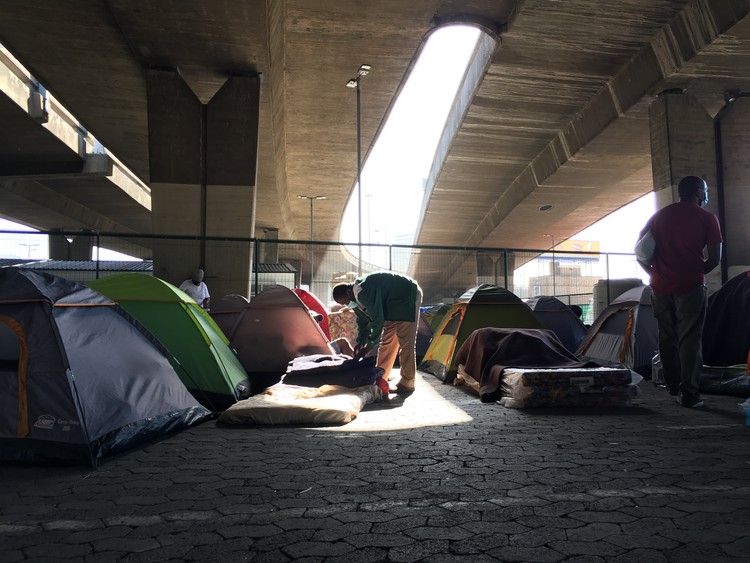
21 May 2024
Public comment on the City of Cape Town’s new “strategy to reduce rough sleeping” will close on Wednesday. Archive photo: James Stent
The City of Cape Town’s new “Strategy to Reduce Rough Sleeping” will replace its current “Street People Policy” if approved. The opportunity for public comment on the strategy closes on Wednesday.
In 2020, the City’s social development department initiated a review of its 2013 “Street People Policy”. The nearly 50-page strategy document is the outcome of this.
The strategy document defines rough sleeping as sleeping on streets, in vehicles, in open spaces or in buildings not meant for living in, and in shelters. It has a detailed analysis of the challenges of rough sleeping and the problems with the state’s response to it. It’s less concrete on how to fix homelessness, but it does have some important proposals.
“The Census study conducted in 2022 found that there were 6,630 rough sleepers on the city’s streets. Previously, the Western Cape Government estimated that were approximately 4,682 street people in the city, 700 of which lived in the Central Business District.”
However the document points out that data on rough sleeping in the city is inadequate.
There are many reasons why people sleep rough, the document emphasises. For example, there are people who are chronic rough sleepers, people who episodically sleep rough and also people who sleep rough temporarily before getting back on their feet. There are also people born on the street and who live rough their whole lives.
The document says that since 2013, Covid and worsened economic conditions have caused “considerable contextual changes to the rough sleeping environment in Cape Town”.
People have been “left socially vulnerable” as “lockdowns lead to job, food and housing insecurity, and a further proliferation of homelessness and rough sleeping” within the city.
The new strategy emphasises that rough sleeping is not a crime and that public spaces are open to all. It repeatedly emphasises that the City’s central tenet is that it is a “city of hope for all”.
“As an overarching approach, the City will employ a public health approach to overcoming rough sleeping and assisting rough sleepers.”
“There needs to be a balance between upholding and enforcing by-laws, but also reviewing by-laws and policy instruments that make it difficult for rough sleepers to engage in the typical activities that most people carry out on a daily basis, or in activities that help keep them safe, which may undermine the dignity of rough sleepers. Not finding this balance can exacerbate the problem and create further social exclusion.”
But, the document says, the City will ensure “that policies, legislation and by-laws are applied equally to all residents”
The document describes the main response for people sleeping rough: shelters, those run by civic organisations and the three “safe spaces” run by the City.
Two of the safe spaces run by the City are in Culemborg near the city centre, and one is in Paint City, Bellville. Over 1,600 people were assisted by these three facilities in the 2022/23 financial year, at a cost of R55-million. People can stay in these facilities for up to six months “provided they agree to partake in the social services and developmental programmes on offer”.
The document also notes the role of the government’s public works programme. “While providing a ‘leg-up’, the temporary nature of the employment often undermines the ability of rough sleepers to escape poverty traps, or amass skills in high demand from the labour market. A need exists to create platforms for skilled or relatively well-educated rough sleepers so that they might be supported through developmental programs.”
The document states: “An overarching national framework to fully address homelessness, including rough sleeping and its effects, has never existed in South Africa. This constitutes a large policy deficit, which has led to incoherent homelessness policy and strategy at all government levels.”
Even within the City, the document emphasises, different departments — law enforcement is singled out — do not have a co-ordinated approach to dealing with rough sleeping, and that there is poor data on homelessness in the city, and hence a lack of defined strategic direction about reducing rough sleeping. As an example of poor data, the document points out that the prevalence of disabilities among homeless people in the city is unknown.
The document states: “The City’s Street People Programme Unit (SPPU) has provided a diverse ‘basket of services’ to rough sleepers such as the City’s Winter Readiness Programme, Referral Services, and assisting with relocation, amongst others. … Over the years, a wide range of collaborations have also been formed, leveraging the competencies of various civil society organisations and public sector entities. Nevertheless, despite these efforts, the pressures that result in homelessness have overtaken the capacity of the City’s interventions.”
The document makes some suggestions on the way forward in Cape Town: